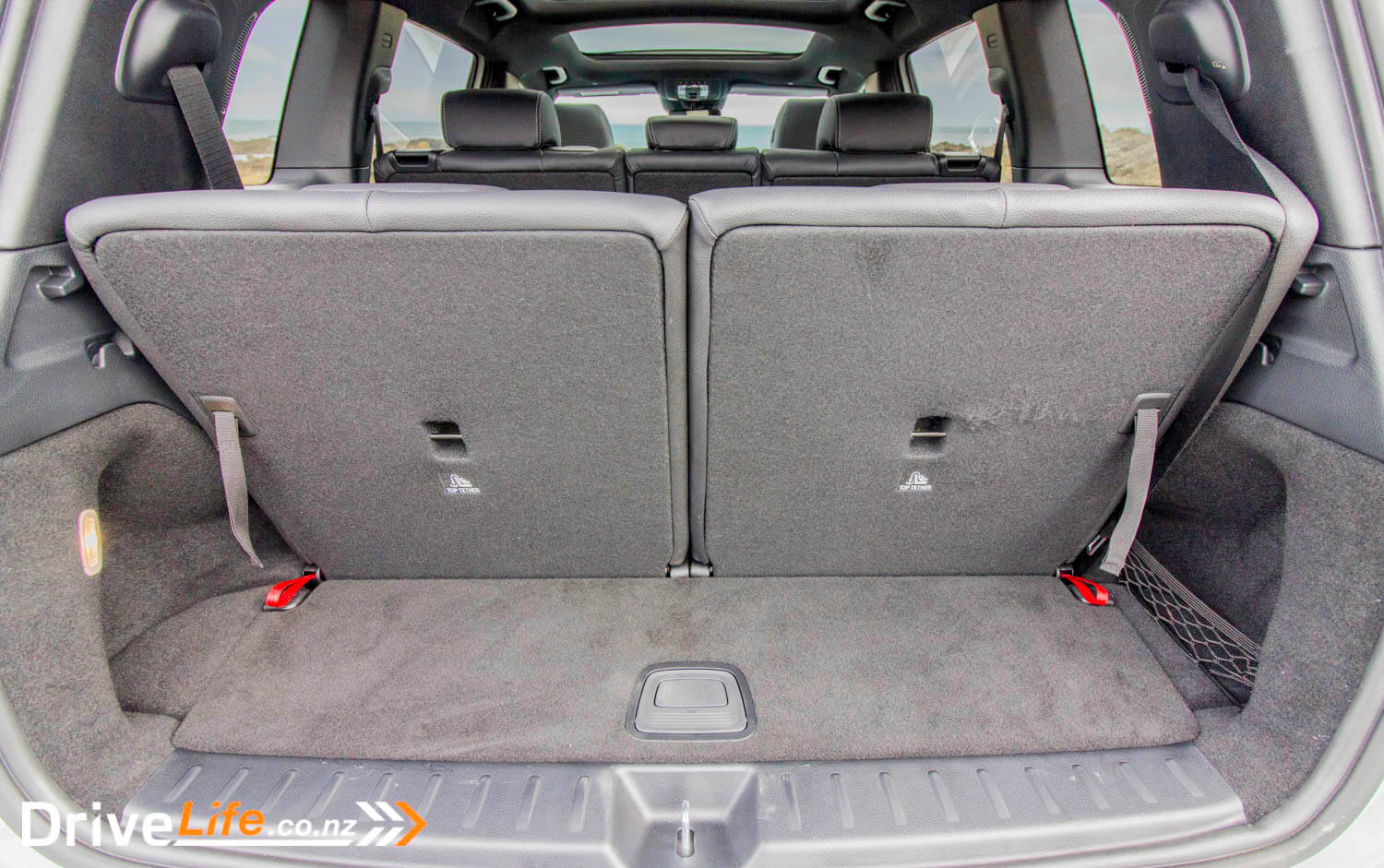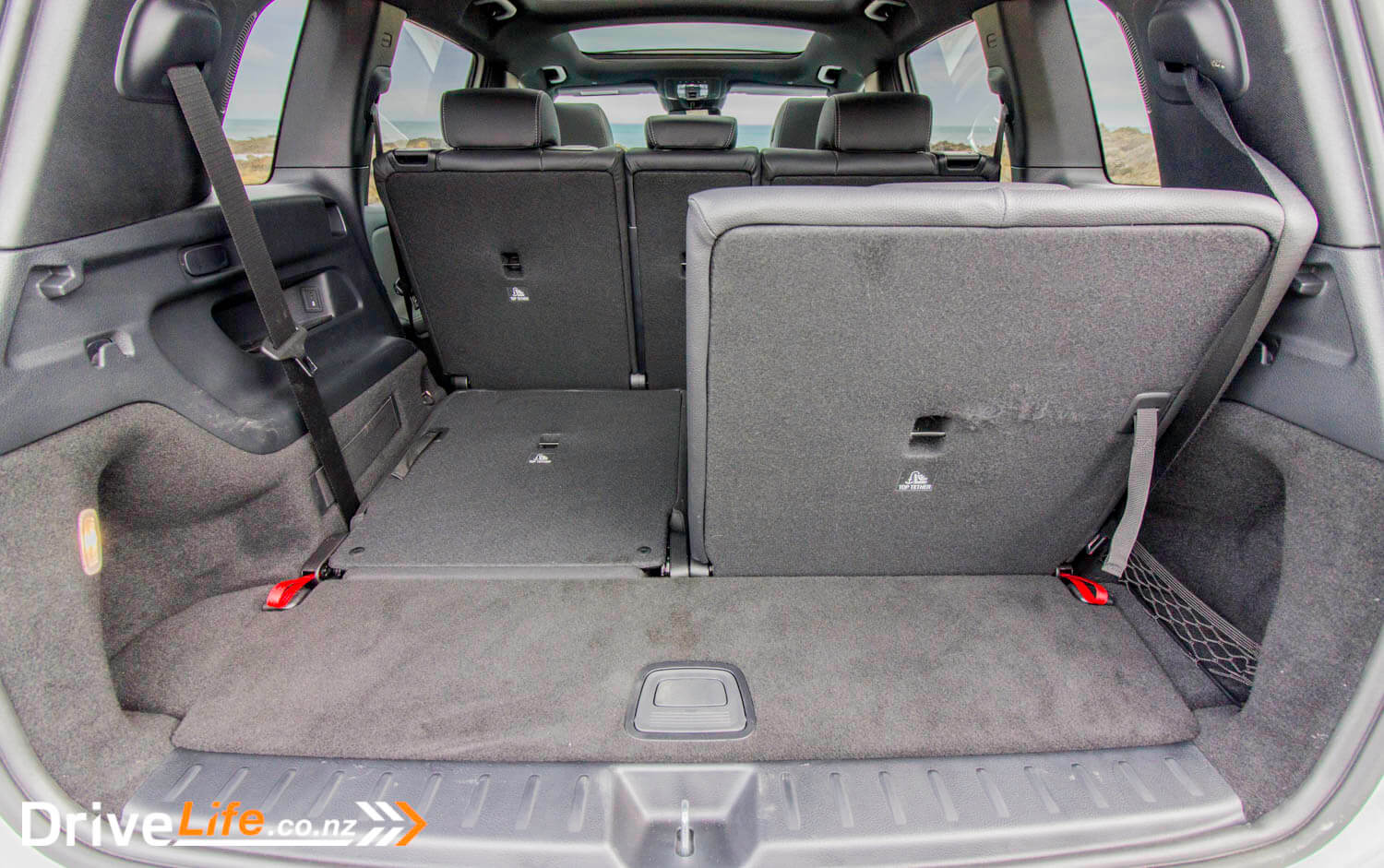With over 40 models available in New Zealand, you’d think that Mercedes-Benz would have the market covered, with a car for every occasion. But there’s always room for one more, it seems. 2020 saw the launch of the all-new GLB, an SUV built on the B-Class platform – and managing to squeeze seven seats in.
That meant an additional model to join the SUV collection of GLA, GLC, GLE and GLS. Can the small New Zealand market cope with another high-end medium SUV? Mercedes-Benz NZ sent us a GLB 250 4MATIC to review.

What’s In The 2020 Mercedes-Benz GLB Range?
There’s three flavours of this car; GLB200, GLB250 4MATIC, and Mercedes-AMG GLB35 4MATIC.
The base model comes with a 1.3-litre, 4-cylinder turbo petrol engine with an output of 120kW of power and a reasonable 250Nm of torque. This model is front-wheel drive only, and has a 7-speed dual-clutch automatic transmission (DCT).
The GLB250 (which we tested) has a 2.0-litre, 4-cylinder turbo petrol engine, that manages 165kW and 350Nm. The GLB35 has the same engine as the GLB250 but pumps power up to 225kW and torque to 400Nm. Both these models are fitted with an 8-speed DCT and are all-wheel drive (AWD).

The GLB200 kicks off at $78,900, and comes standard with 19” alloys, ambient lighting, blind spot assist, keyless entry and start, LED headlamps, the MBUX infotainment system with 2×12.3” screens, SatNav, climate AC, Qi wireless phone charging, auto dimming interior mirror, lumbar adjust for the driver, an electric tailgate, illuminated door sills, the Interior Light Package, reversing camera, automatic high beams, Active Parking Assist with Parktronic, alloy roof rails, electrically folding mirrors, auto wipers, twin exhaust tips, a 225-watt sound system, DAB radio, Apple CarPlay/Android Auto, Active Lane Keep Assist, 9 airbags, Cross Wind Assist, and Traffic Sign Assist.
When you move to the $92,900 GLB250, both front seats are now fully electric and heated, 4MATIC AWD is added, the fuel tank moves from 52 litres to 60, there’s a panoramic sunroof with electric blind, you get the OFF-ROAD Engineering Package, adjustable suspension, and MercedesMe Connect.

The $104,900 AMG model mostly adds AMG decorative bling, like air vents in black with a chrome surround, brushed alloy pedals, AMG performance steering wheel in Nappa leather, some “Carbon Structure Trim”, and AMG floor mats, among other items. Go-faster parts include the more powerful engine, an AMG exhaust system (with Silent Start function), AMG high performance brakes, AMG speed-sensitive power steering, 3-stage Electronic Stability Package, and a host of other goodies. For the amount of extra kit and performance over the GLB250, it’s actually quite good value.
All models are seven seaters.
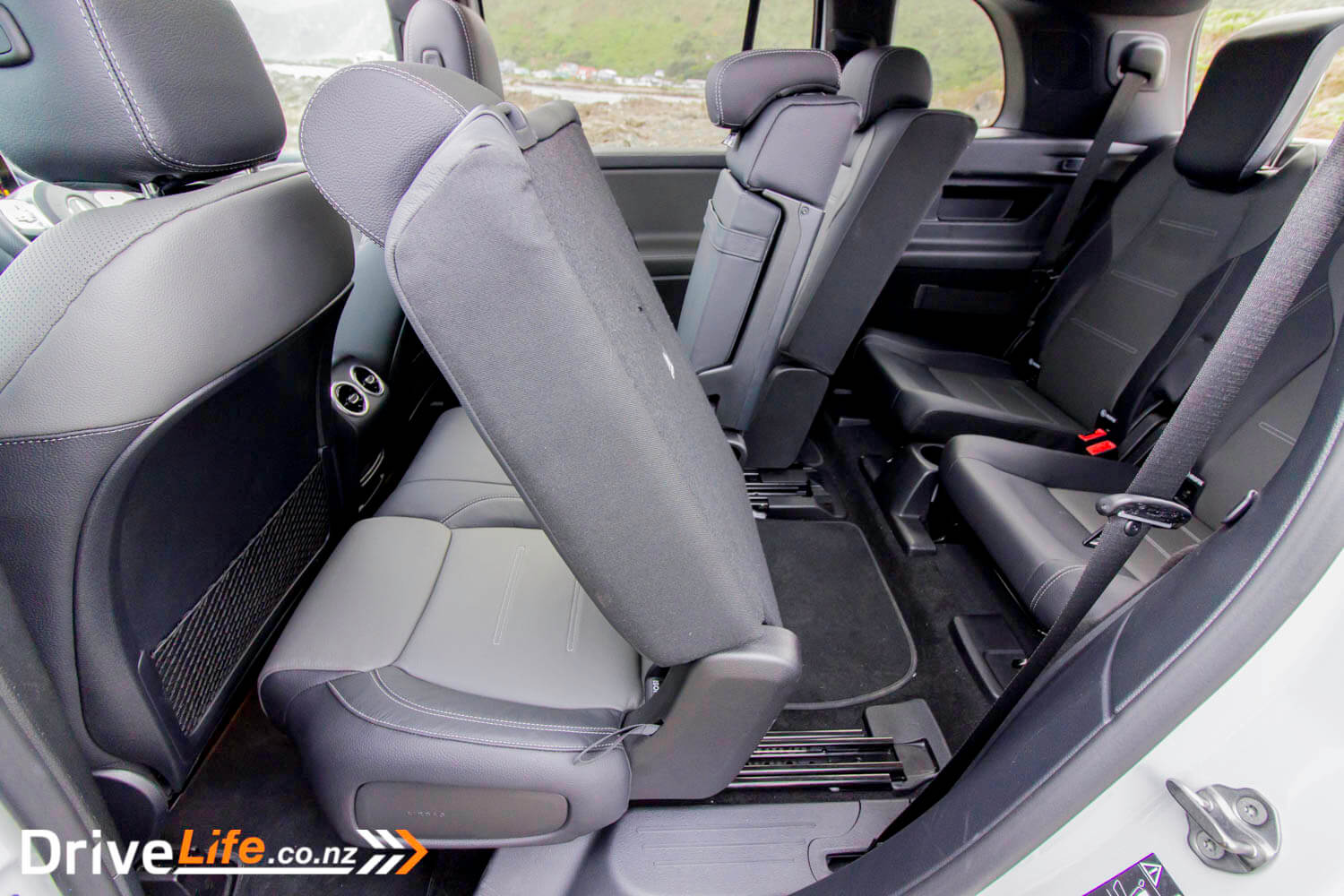
Our test car was, as always, fitted with some optional items; Digital White Metallic Paint cost $1,490, the Sports Package is $1,990, AMG Exclusive Package $2,490, 20” AMG multi-spoke wheels $1,990, the Driving Assistance Package at $1,990, and the Vision Package at $1,190. This bought the price of our test car up to $104,040.
You can read more about the GLB on Mercedes-Benz New Zealand’s website.
First Impressions Of The 2020 Mercedes-Benz GLB 250
Well, while it’s still distinctively a Mercedes-Benz (MB), I’ve got to say the GLB does have a different look to it. Front on, those headlights are a departure from other MB SUVs, with double LED daytime running lights around most of the perimeter of the headlight. They look quite cool when they’re on.

Side on, the GLB looks quite stumpy and tall, like a photo that’s been dragged out of proportion. In saying that, it’s 10cm longer than the B-Class hatch. That’s not to say it doesn’t look good. Our test car was fitted with some optional 20” black AMG multi-spoke wheels ($1,990) and they suited the car perfectly, giving it a bit of a sporty stance.
Getting up close, the GLB does feel big all round, probably due to its height. Things at the rear are pretty good too, with some flattened-oval exhaust tips looking very sharp.
The whole design of this car just seems to work.

What’s The Interior Like On A 2020 Mercedes-Benz GLB 250?
Like Audi and BMW, a Mercedes-Benz SUV interior is pretty much the same between all models. That’s not a bad thing, as quality is absolutely top of the class. Everything looks beautifully finished, and feels the same. Touch points in any MB SUV are going to be great.

One of those touchpoints is the aluminum toggle switches up front that control heating, and some other functions; they feel fantastic under your fingers. In fact, the tactile feel of all the switches in the GLB are awesome.
For the GLB, Mercedes-Benz has added some alloy tube to the console, doors and dash. It doesn’t look out of place, and at least makes the GLB unique in a small way. There’s also some gloss, fake carbon fibre on the dashboard, because carbon fibre.
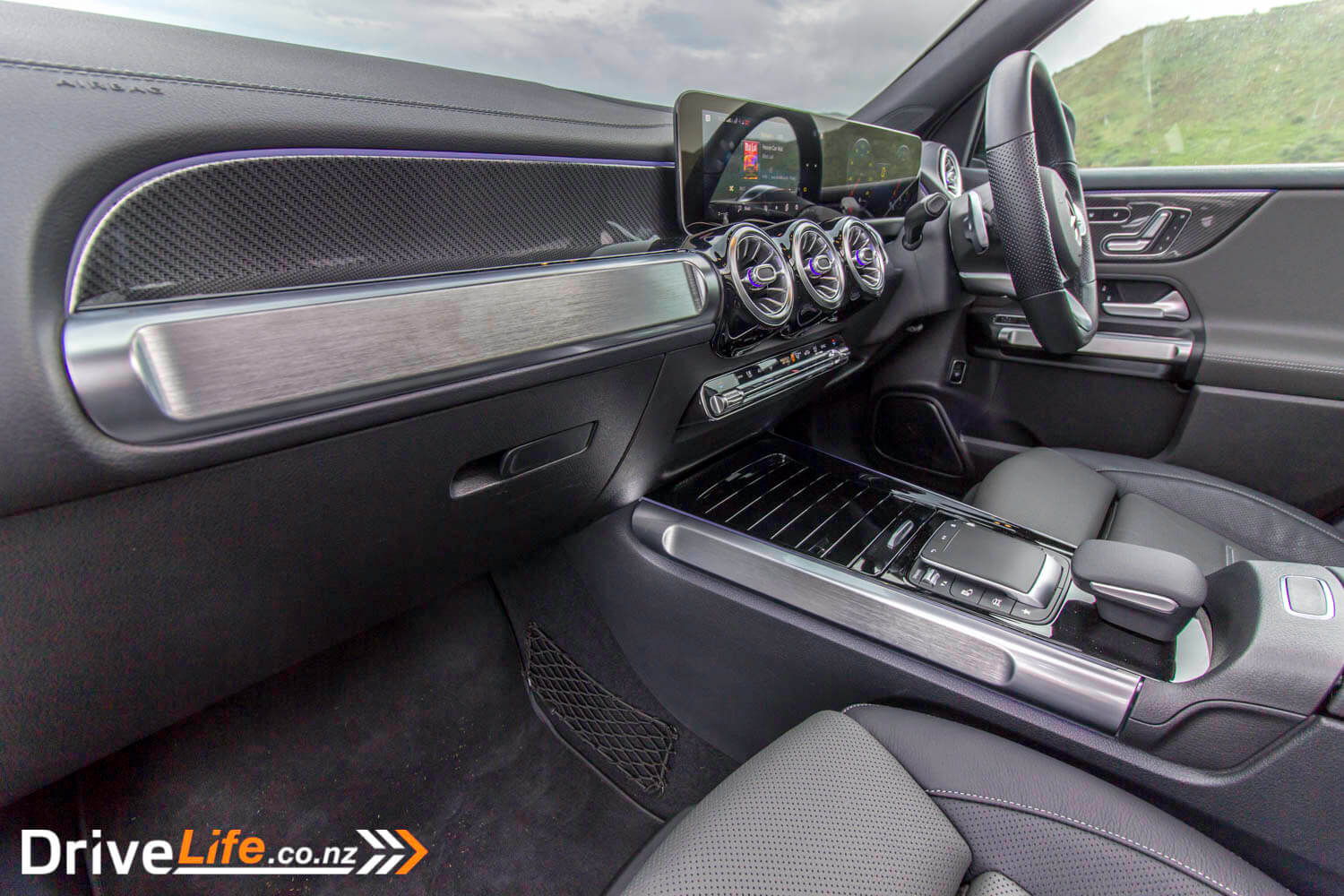
But it’s the headroom in the interior that gets you when you first sit. With a double sunroof (with the front part tilt/slide and the rear fixed) it feels light, and there is a huge amount of headroom. The headlining seems so far away. I know I’m not the tallest guy out there, but man, the GLB has gallons of space above your head. According to Mercedes-Benz, at 1035mm (!) for the front row passengers, the GLB is class-leading for headroom. There’s an electric blind that covers both sunroofs if you feel the need to shut the world out.

So there’s plenty of space in the front, but there’s also plenty in the second row too. The rear seats are sliding, so if there’s no one in the third row, you can get your legs sticking right out. Shoulder room is good, too. There shouldn’t be any complaints from your GLB passengers about their personal boundaries being minimised.
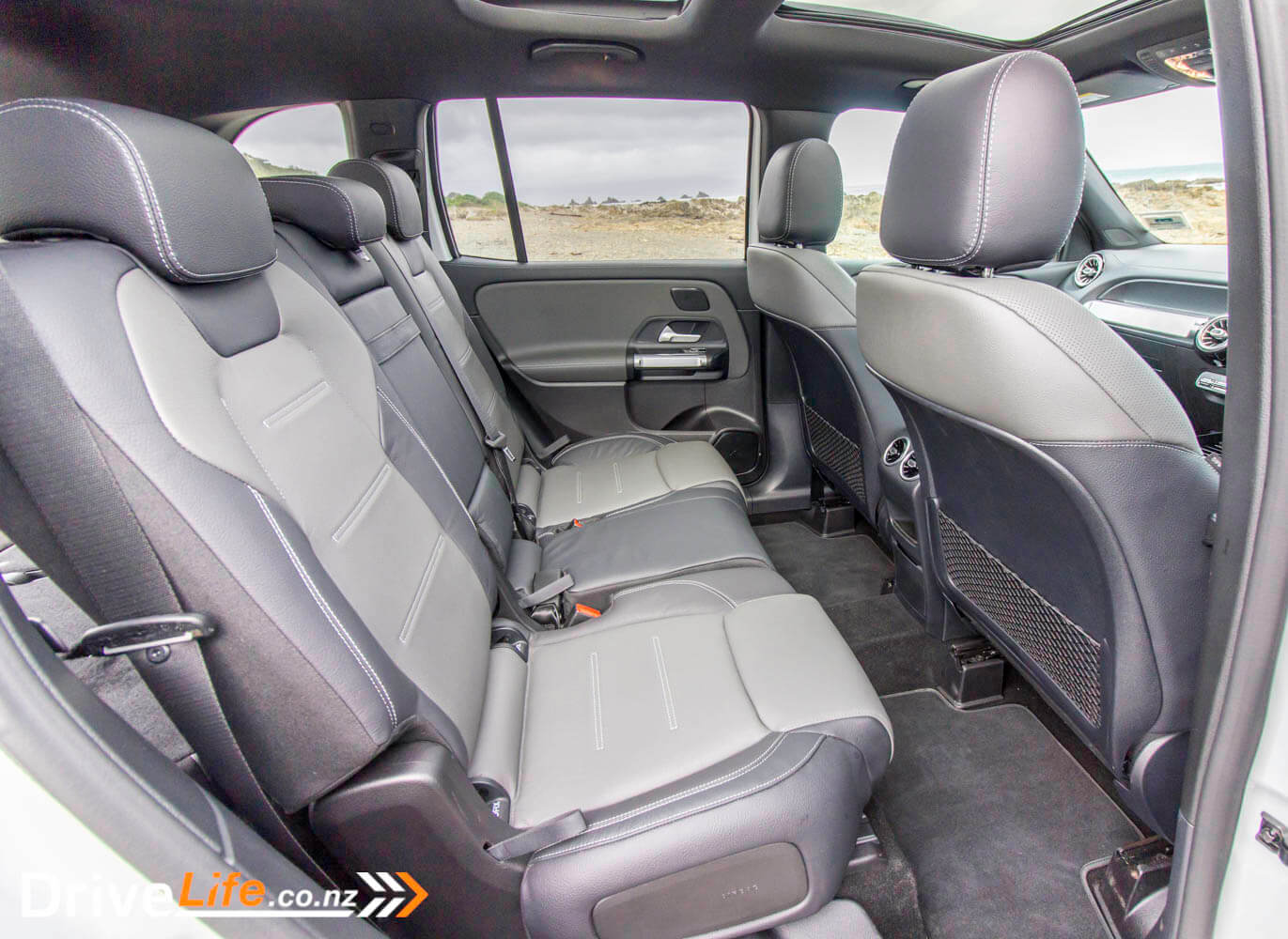
So what about the third row? It’s tighter back there, and I’d call it more of an occasional third row. It’s designed for passengers under 1.68m tall. With the second row pulled forward, leg room isn’t too bad, but I’d be cautious about taking 7 people on a long trip. While 7 seats is an option overseas, it’s standard on New Zealand models.

At least the third row passengers get a USB-C port on each side, and also cup holders right there in between the seats. They’ve also got their own small storage cubbies. Second row passengers also have two USB-C ports, there’s another two in the centre console cubby, and then another one up the front of the dash, along with a single 12-volt socket.
With the third row up, boot space is not disclosed, but it’s not large – but that’s typical of a smaller 7-seater. With the third row down, space is a very good 565 litres.
What Does The 2020 Mercedes-Benz GLB 250 Drive Like?
My last experience in the B-Class was just okay – I didn’t really enjoy it. The dual-clutch transmission (DCT) was very jerky at low speeds, and put a damper on my enthusiasm for the whole car. I was desperately hoping the GLB would not be the same, and it isn’t – it’s far better. Fitted with an 8-speed DCT, the transmission in the GLB is a lesson to anyone else building a dual-clutch automatic. Never jerky, always perfect changes up and down the ‘box, and lightning quick when you’ve got the car in Sport mode. It’s exactly what we’ve been promised for a DCT for years.

In fact, the whole driving experience of the GLB is great. We took the GLE on a Far North Adventure last month, and I thought there was no better holiday wagon, but at near on $50,000 less, the GLB is even more appealing. Since we had the GLB 250 on test, that meant we had the 2.0-litre, 4-cylinder turbo-petrol engine with an 8-speed DSG automatic, and ‘4MATIC’ – Mercedes-Benz’ term for AWD. Along with the transmission, that completely-upgraded engine is superb. With plenty of power and torque, and an awesome engine tone when you wind it out, the engine in the GLB250 makes the car. It’s quiet when you want it to be, but give it some beans, and you are rewarded with an engine noise that says “I’m a tuned, turbocharged, four cylinder and this is how good I can sound.” Even when I didn’t need to, I gunned it now and then just to hear it. There’s no crackles and pops, but the sound this turbo makes is a delight for the man-child in you.

In Sport mode, things go up another notch, with tightened suspension, quicker gear changes and more performance. There’s even some rev matching going in between gear changes, to add more sportiness to the drive. The 4MATIC AWD system also changes with drive modes, with Eco 80/20 (front/rear), Sport at 70/30, and Off-Road set at 50/50.

It’s fun in Sport mode, but surprisingly, Eco mode was where it was at for me. The GLB glides along in Eco mode effortlessly, with plenty of torque in reserve to maintain a higher gear. You can still floor if needed to get out of trouble, but it’s a nice, sedate way to commute. If only the GLB remembered what drive mode you left it in when you get back in the car (it reverts to Comfort mode), but then this is true of all Mercedes-Benz models.
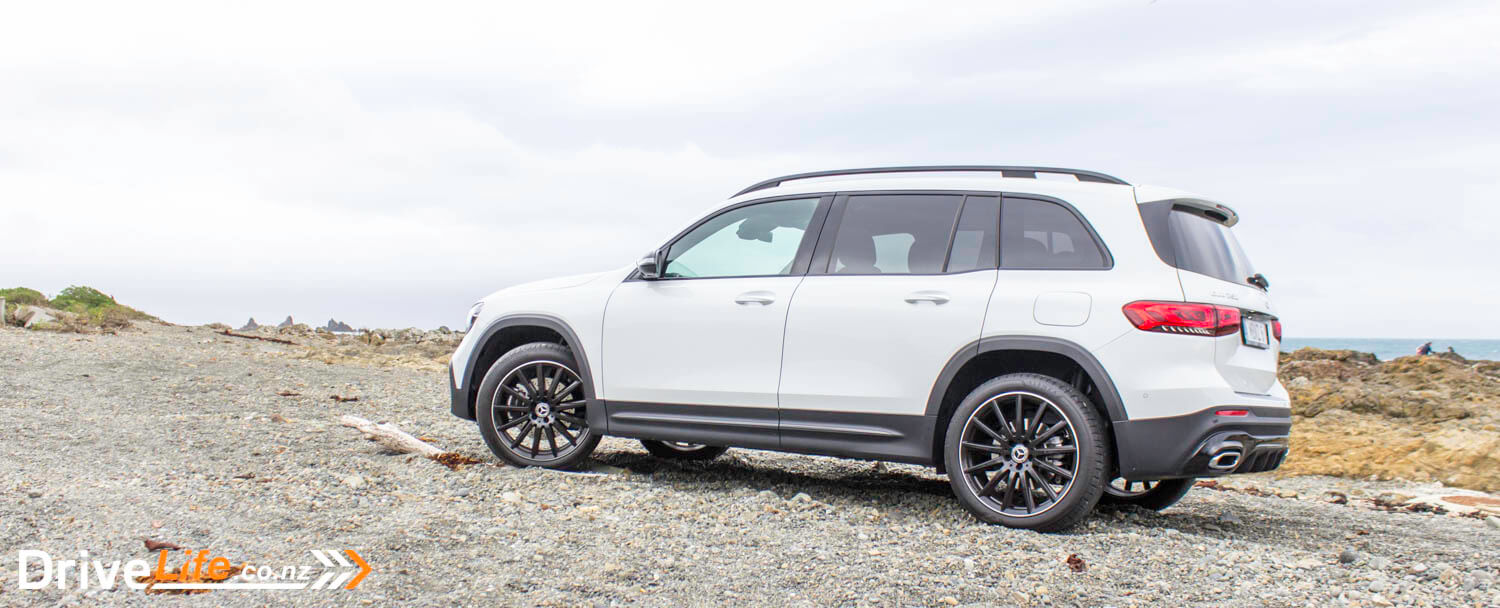
When you aren’t giving it the gas, the GLB250 is still awesome. With massive side windows and that huge double sunroof, visibility is excellent and as always, there’s blind-spot monitoring to help you along. There’s steering assist as well, which is handy for taking over lane changes on the motorway, and even better – in a traffic jam. The GLB can crawl along at low speeds with adaptive cruise and steering assist on, taking away the potential to rear-end someone.

We’ve covered off the adaptive cruise control in Mercedes-Benz cars before, but it’s still worth highlighting. While other brands do it well, MB does it almost perfectly. It can bring you to a stop of course, which is always handy on Wellington motorways that crazily have traffic lights on them. Then, when the traffic starts to move again, it will move forward without any input from the driver. Not only that, but there’s also the GPS tracking option, that will slow the GLB down for corners, so it doesn’t take them too fast. I’ve mentioned this system before – it’s a bit too nanny-like for me, as it slows the car down too much for my liking, but the feature is there if you want to use it. Another nice feature of the MB system is that you can set cruise control with a single button – no need to turn it on, it’s ready to go. Also, if you pass a speed limit sign, you can double-tap the Resume button to set your current speed to the speed limit. Note that these are all part of the Driving Assistance Package included in our test car, at $1,990.
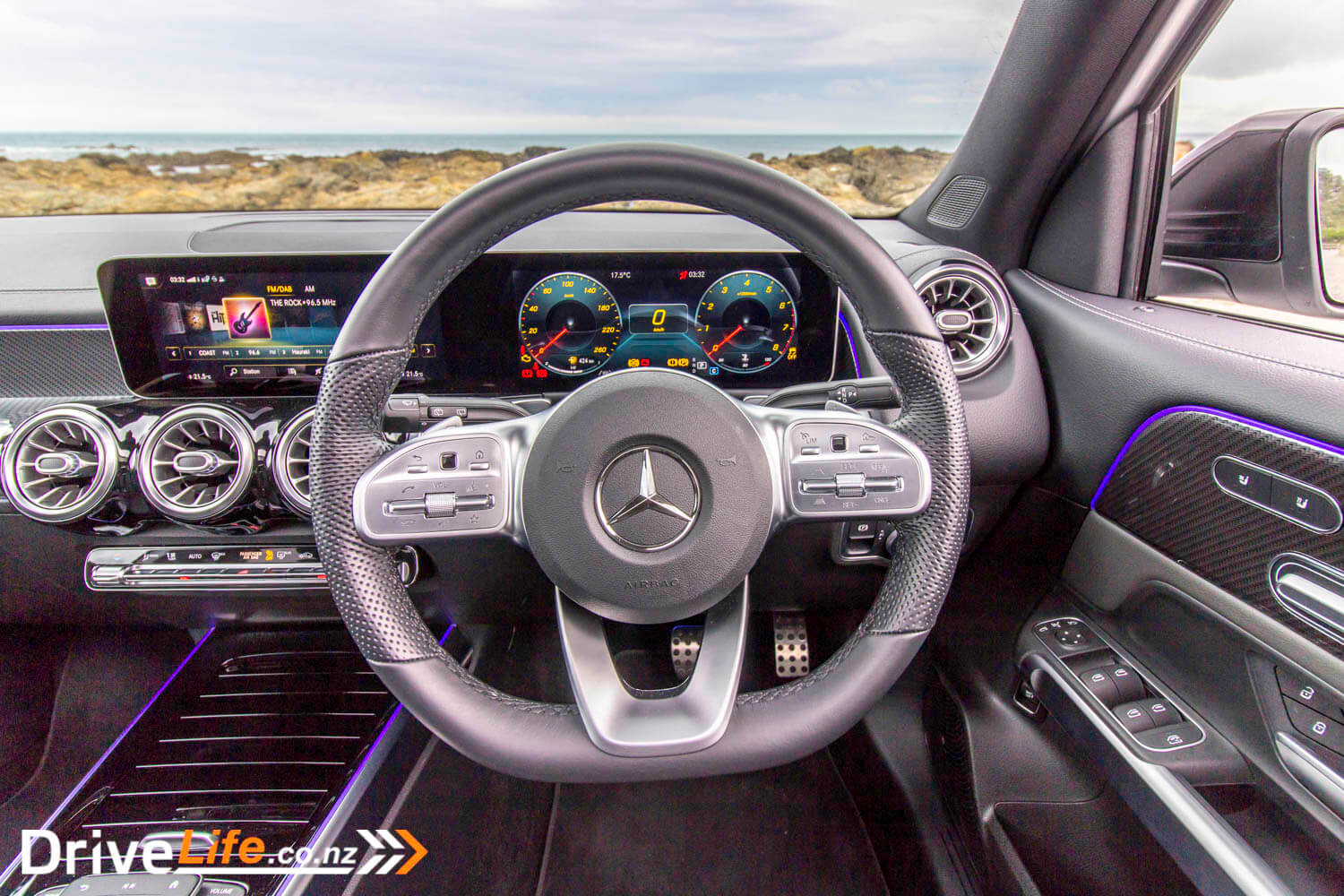
It’s incredibly surprising that at $92,900, the GLB250 doesn’t come with adaptive cruise control as standard. A Suzuki Swift RS at less than $27,000 has adaptive cruise control, as do all Toyota Corollas. It’s time for the euro brands to step up and make adaptive cruise control as standard too. The GLB250 does have some nice additions to adaptive cruise, as mentioned, but a buyer should not have to pay almost $2,000 more to get something that a Corolla has – especially when the base price is over $90,000. Hell, even the $104,9000 AMG version doesn’t have adaptive cruise.

Ride quality in the GLB is a bit of a mixed bag; generally, it’s quite compliant, but it can get a bit bouncy at times. I expect with weight on board it would even out nicely. With such a high car, you’d think that when pushing around a tight road, there’d be gallons of body roll. Actually, it’s not bad, and the grip from those Bridgestone tyres is always excellent. You can really push the GLB through tight corners. If you go too hard, the rear will start to slide and then going harder, the front will as well, turning into a nice, controllable 4-wheel drift. It’s not what the GLB was designed for, but it copes nicely in the handling department.

Our test car was fitted with the Vision package. This means we had Adaptive Highbeam Multibeam ASSIST Plus headlights, and the Parking Package which includes automatic parking and a 360-degree camera system. If I was ordering this car, I’d be adding this. The headlights in the GLB with this package are outstanding in both quality and function. The adaptive LEDs operated perfectly, never blinding another driver in front or on the other side of the road. While on the motorway, I had high-beams lighting up the entire left side of the road while driving behind another car. With no traffic about and no streetlights, the high-beams stretch off into the distance, wide and high. They rival BMW’s laser headlights, which cost a lot more. As a bonus, starting the car at night sees the headlights do a little ‘dance’ left and right, up and down, and then coming together. Kids love it, as does the occasional adult. At $1,190 this option would be a tough one to say no to.

We’ve also covered off the 360-degree camera system in other reviews, and thankfully it’s unchanged. So easy to use – hit the Park button on the centre console, and the car is ready to look for a spot to park itself in. Or, after hitting that button, you can scroll down through a list of views of front, side, rear, both left and right kerbs (for parking), and other views. Like other brands, the cameras automatically come on if you get too close to another object, turning on the camera closest to the hazard. This is one thing I absolutely miss when handing a car back after a review of it.

As per other MB models, the GLB is fitted with two 12.3” screens that control all functions. These have been covered at length in our other reviews, and they function exactly the same in the GLB, and that’s totally fine with me. They are excellent. Also fitted to this model is the MBUX infotainment system, which includes Mercedes Me. This is a voice-activated system that you use to control air con, SatNav, and other car functions. You can also use it to check the weather, find hotels or restaurants. I could see this being pretty useful for the owner, over the long term. It’s pretty intelligent too; the driver can say something like, “I’m too hot”, and the car will reduce the temperature on the driver’s side only. Ditto for the front seat passenger – they can tell Mercedes Me that they are too hot/cold, and the car will alter the temperature for that side of the car only.

With 165kW of power in a heavy SUV, you’d be thinking that it’s a bit of a gas guzzler. Over 600km, I managed 9.0 litres/100km, which I felt was reasonable. Mercedes-Benz suggests it should be 7.4, so I wasn’t too far away from that.

What’s The Competition For The 2020 Mercedes-Benz GLB 250?
| Brand/Model | Engine | Power/ Torque kW/Nm | Cargo capacity, litres | Fuel consumption, L/100km | Price |
| Lexus RX350 F Sport AWD | 3.5-litre V6 petrol | 221/370 | 519 | 9.6 | $109,799 |
| BMW X3 xDrive 39i xLine AWD | 2.0-litre, 4-cylinder, turbo petrol | 185/350 | 460 | 7.4 | $102,900 |
| Volvo XC60 T6 R-Design AWD | 2.0-litre, 4-cylinder, turbo-supercharged petrol | 246/440 | 635 | 8.0 | $97.900 |
| Mercedes-Benz GLB250 4MATIC AWD | 2.0-litre, 4-cylinder, turbo petrol | 165/250 | 565 | 7.4 | $92,900 |
| Jaguar E-PACE R-Dynamic AWD | 2.0-litre, 4-cylinder, turbo petrol | 224/400 | 577 | 8.7 | $89,900 |
| Audi Q3 45 TFSI S Line AWD | 2.0-litre, 4-cylinder, turbo petrol | 169/350 | 460 | 7.6 | $85,900 |
What’s The Pros and Cons For The 2020 Mercedes-Benz GLB 250?
| Pros | Cons |
| Surprising handling Comfort levels Quality of finish Interior Space Visibility Transmission Engine Headlights (option pack) Adaptive cruise functionality (option pack) | Adaptive cruise control $2,000 option Ride can be bouncy |
2020 Mercedes-Benz GLB 250 – Specifications
| Vehicle Type | 5-door, 7-seat, AWD medium SUV |
| Starting Price | $92,900 |
| Price as Tested | $104,040 |
| Engine | 2.0-litre, 4-cylinder, direction injection, turbo petrol |
| Power, Torque kW/Nm | 165@5,800rpm 350@1,800rpm |
| Transmission | 8-speed DCT |
| 0-100km/h, seconds | 6.9 |
| Spare Wheel | Pump only |
| Kerb Weight, Kg | 1,721 |
| Length x Width x Height mm | 4634x2020x1658 |
| Cargo Capacity, litres | 565/1800 |
| Fuel capacity, litres | 60 |
| Fuel Efficiency | Advertised Spec – combined – 7.4L/100km Real World Test – combined – 9.0L/100km Low Usage: 0-6 / Medium Usage 6-12 / High Usage 12+ |
| Towing Capacity Kg, unbraked/braked | NA |
| Turning circle, metres | 11.7 Small: 6-10m / Medium 10-12m / Large 12m+ |
| Warranty | 3 Years unlimited KM |
| ANCAP Safety Ratings | 5 Star |





